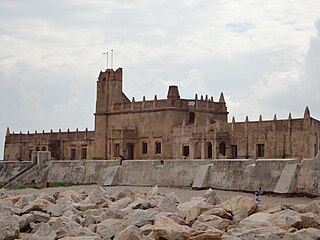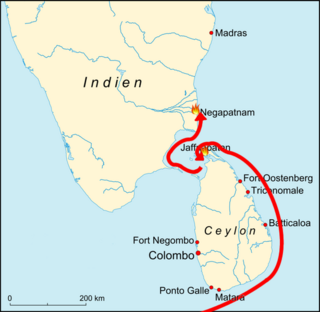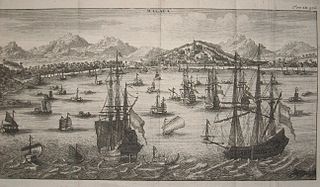
Danish India was the name given to the forts and factories of Denmark in the Indian subcontinent, forming part of the Danish overseas colonies. Denmark–Norway held colonial possessions in India for more than 200 years, including the town of Tharangambadi in present-day Tamil Nadu state, Serampore in present-day West Bengal, and the Nicobar Islands, currently part of India's union territory of the Andaman and Nicobar Islands. The Danish and Norwegian presence in India was of little significance to the major European powers as they presented neither a military nor a mercantile threat. Dano-Norwegian ventures in India, as elsewhere, were typically undercapitalized and never able to dominate or monopolize trade routes in the same way that British, French, and Portuguese ventures could.

The Capture of The Bengali Prize, or the Seizure of The Bengali Prize, was a Danish capture and seizure of a larger Bengali vessel in late 1642 in the Bay of Bengal. The capture is known to be the first confrontation of the Dano-Mughal War, after the formal declaration of war.

The siege of Dansborg or the siege of Fort Dansborg, was a short siege lasting from 20 to 30 December 1644, between general Tiagepule of Thanjavur and the Danish command at Fort Dansborg. The conflict started over the Danish rejection of the general's demand to tax Tranquebar, and as a result, a series of confrontations followed. The confrontations had no major result, and an armistice may have been signed.

The siege of Dansborg alternatively the siege of Fort Dansborg sometimes also referred to as Willem Leyel's siege of Dansborg, was a siege initiated by traveler and seafarer, Willem Leyel, against the men loyal to governor Bernt Pessart. The siege was concluded after the men at Dansborg opened the gates for Willem Leyel, surrendered, and accepted Leyel as the new governor.

The siege of Dansborg or the siege of Fort Dansborg, was a siege of the newly finished Danish fort of Dansborg in Trangebar in 1624. The siege was initiated by the nayak of Thanjavur, Raghunatha, because of the Danish rejection of the demands from the nayak. The siege, laid by general Calicut, was abandoned after the arrival of Danish reinforcements from sea. The event is mostly described by Icelander, Jón Ólafsson, in his work The Life of the Icelander Jón Ólafsson, Traveller to India.

Roland Crappé's raids on Portuguese colonies refers to a series of raids by Dutchman in Danish service, Roland Crappé, on Portuguese Ceylon and India. The raids were partially unsuccessful, in that Crappé's ship, Øresund, caught fire and sank.
Willem Leyel or Willum Leyel was a Danish governor of Tranquebar and captain in the Royal Dano-Norwegian Navy.

The Skirmish at the Strait of Malacca was a skirmish in 1644 between the claimed governor of Tranquebar, Bernt Pessart, and the local authorities of Dutch Malacca. The confrontation led to the imprisonment or death of all of Pessart's crew and the confiscation of the vessel, Dend gode Haab. Although Pessart and his crew would later be released and cooperate with the Dutch to spy on the Spanish in Manila.

The Ambush near the Bay of Manila, alternatively the Death of Bernt Pessart, was an ambush by the Indigenous peoples of the Philippines, against a combined Dano-Dutch espionaging expeditionary force in 1645. The ambush led to the death of former governor and president of Danish India, Bernt Pessart.

The sieges of Tranquebar or the War between Tranquebar and Thanjavur refers to the warfare between the Thanjavur Nayak kingdom and Danish Tranquebar between 1655 – 1669. The Thanjavurian sieges were repelled, mainly due to the new fortifications being built around Tranquebar, and a peace agreement was issued in 1669.

The Conflict between William Leyel and Bernt Pessart refers to the tensions and minor civil war between Willem Leyel and Bernt Pessart over the governorship of Tranquebar and the Danish East India Company. The conflict led to the escape of Bernt Pessart, and the command at Tranquebar accepted Willem Leyel as governor of Danish India.

The Capture of St. Michael or the Seizure of St. Michael, was a Danish seizure of a Bengali ship in the Bay of Bengal. The Danes captured the Bengali ship and the vessel was subsequently incorporated into the Danish Navy given the name St. Michael.

The Attack in Hooghly was a Danish attack on two Bengali ships during the Dano-Mughal War in 1671. The Danes succeeded in blowing up the Bengali ships, and violence continued off the coasts of Kalingapatnam and Balasore.

The Battle of Balasore was an engagement between Bengali and English ships against Danish ships at Balasore. When the English failed to persuade the Danes, the Bengalis started attacking the English vessel, yet the English were rescued by the Dutch.
Roland Crappé or Roelant Crappé was a Dutch colonial official serving the Dutch and Danish East India Company. He became director general of the Ceylonese department of the Danish East India Company in 1618 and became commander in chief and governor of Tranquebar upon his seventh arrival in the Indies in 1624. During his leadership, new factories and offices were established and Danish trade went exceptionally well. He died in 1644 only a few years after his homecoming to Denmark.

The Tranquebar Rebellion also known as the TranquebarMutiny was a bloodless mutiny and uprising against the governor of Tranquebar, Willem Leyel, at Tranquebar in 1648. The mutineers succeeded in arresting Leyel, and he would be replaced by the leader of the rebellion, Paul Hansen Korsør.
Bernt Pessart, Berndt Pessart or Berent Pessart was a Dutch overhoved and self-proclaimed President of Danish India from 1636 to 1643. In his early years, he served the Dutch East India Company in Bantam, and in September 1636 he became governor of Danish Tranquebar. He would serve as governor until his deposure in 1643 when he would flee to Japan. During his exile, Pessart would be confronted by the Dutch at Malacca, in which he would be detained and imprisoned by Dutch authorities. His imprisonment would be taken to a court in Bantam, where the judge ruled he would again serve the Dutch by espionaging on the Spanish in the Philippines. He would die in June 1645 during a voyage to Manila by an ambush of local natives.

The Expulsion of Danes from Balasore was a violent expulsion and ousting of the Danish East India Company from the Mughal harbour and trading hub of Balasore in 1643 or 1644 by the local Mughal governor, Malik Beg.
The frigate and man-of-war Flensborg, or Flensburg, was a Danish East Indiaman sent on 2 December 1629 to Tranquebar as the third cargo to India. However, it was blown up by the Portuguese off the Cape of Good Hope in 1630.
Anders Nielsen was a Danish colonist and acting governor of Tranquebar from 1643 to 1648, in times when overhoved Willem Leyel was absent. During his service as acting governor of Tranquebar, Nielsen would defend the town from Thanjavurian General Tiagepule and support a mutiny against overhoved Leyel.
















